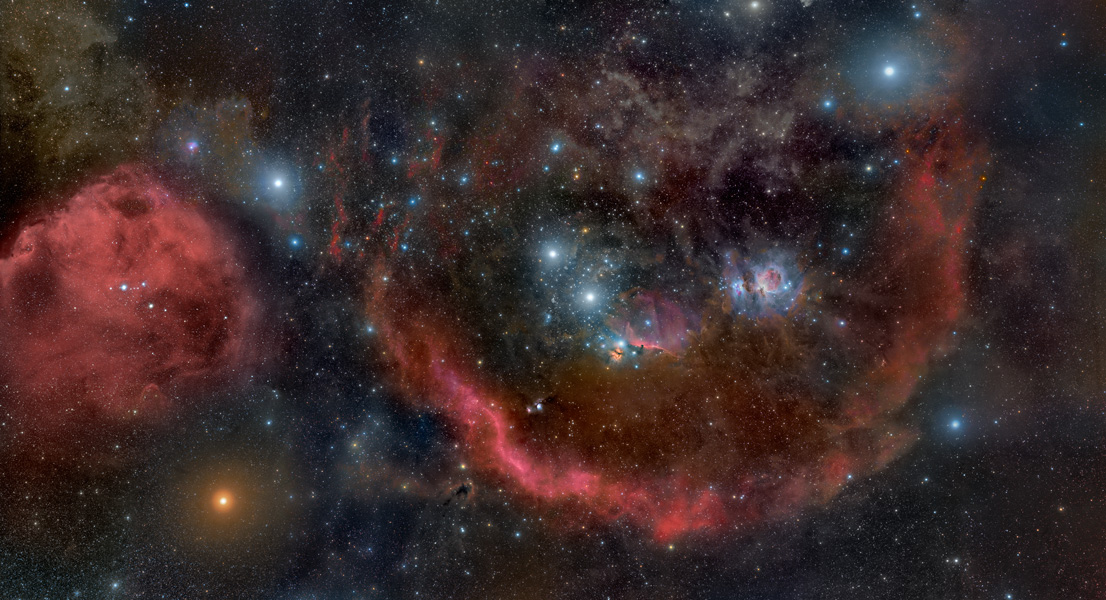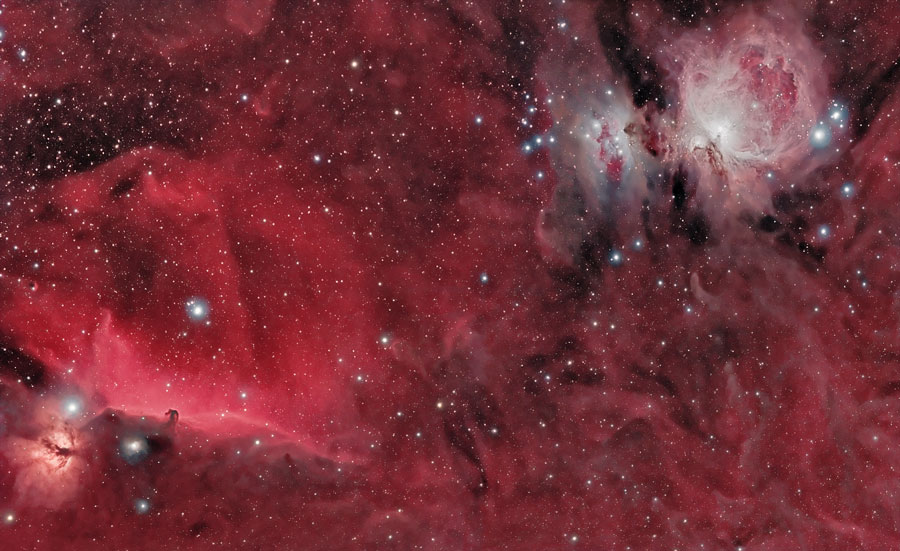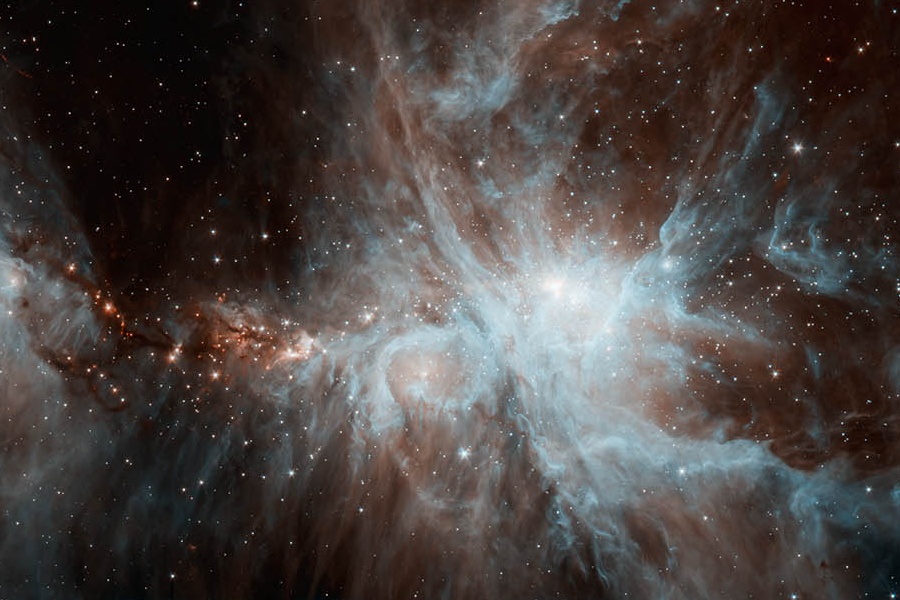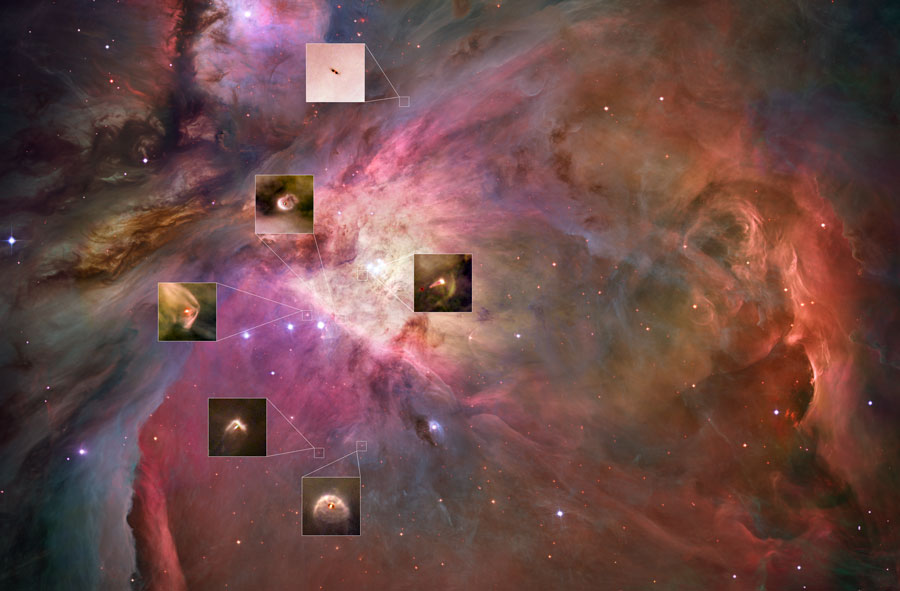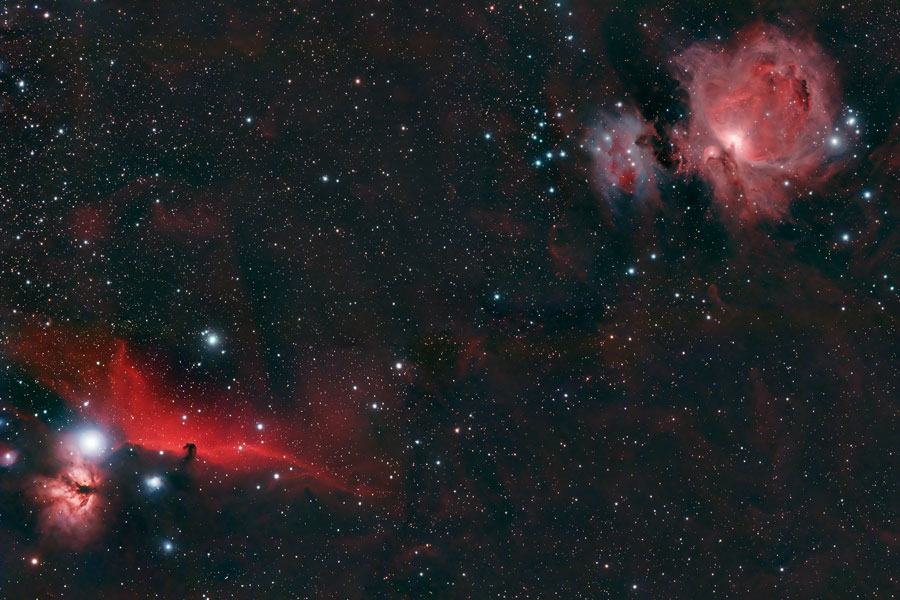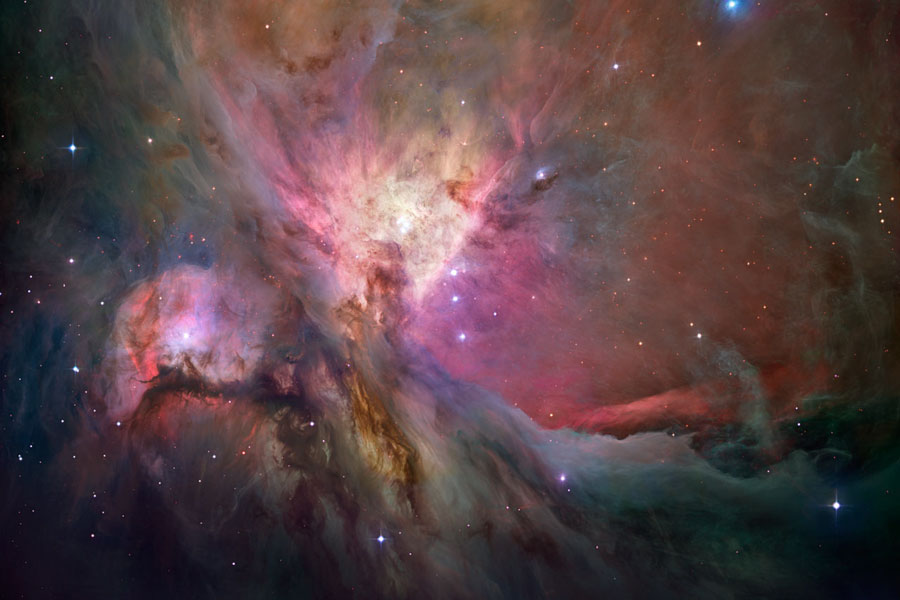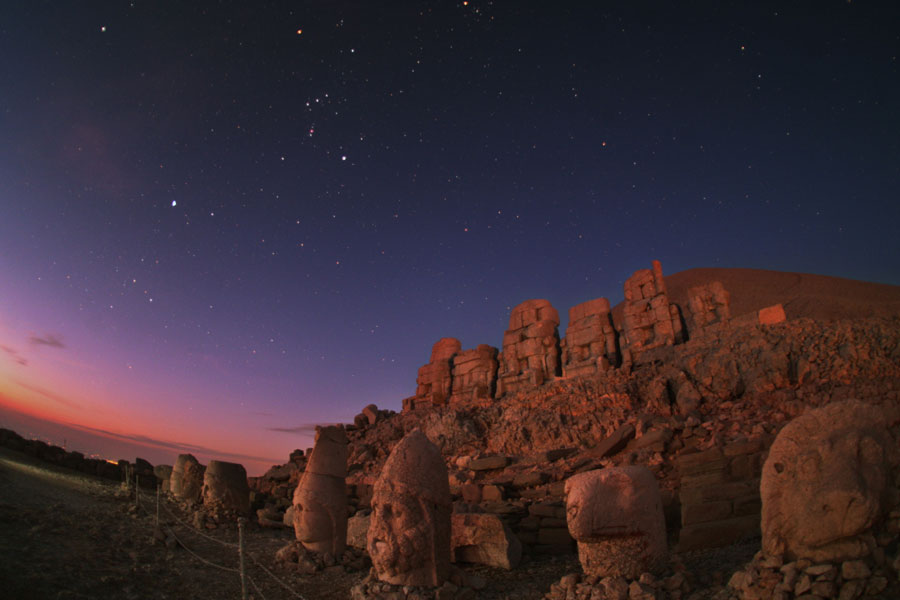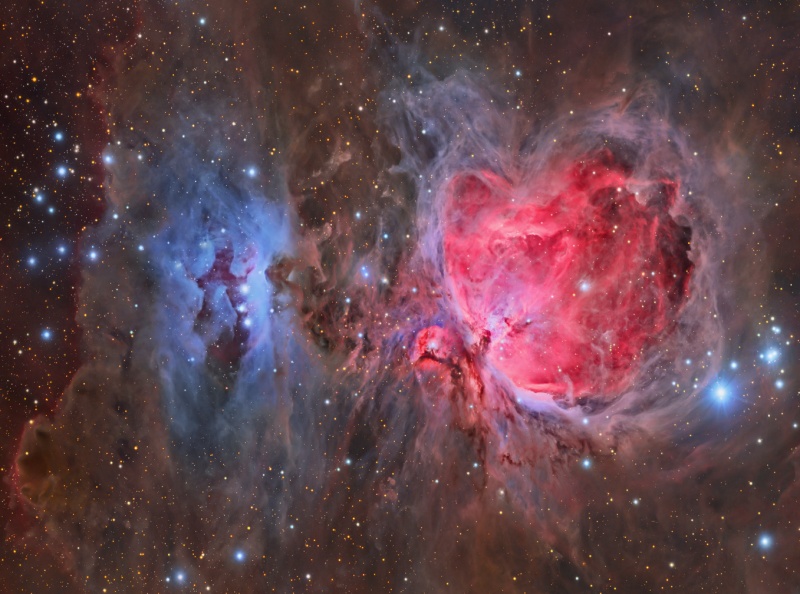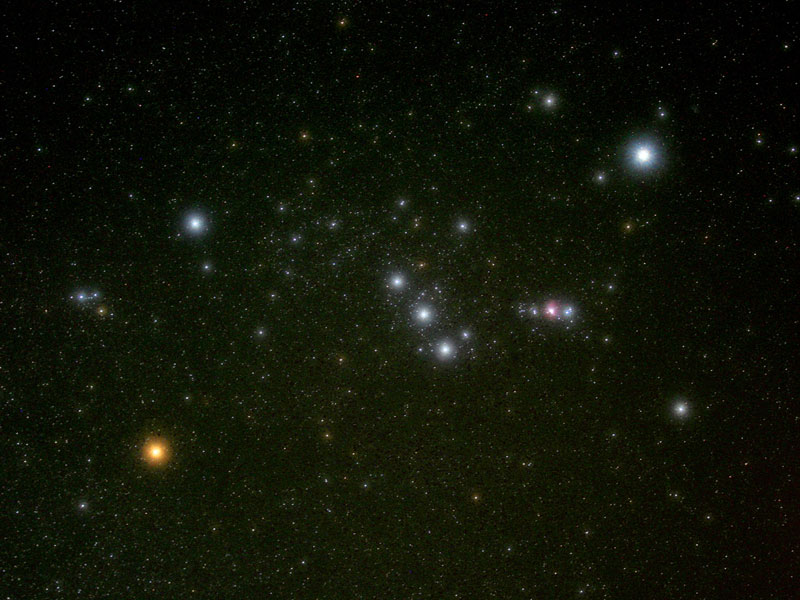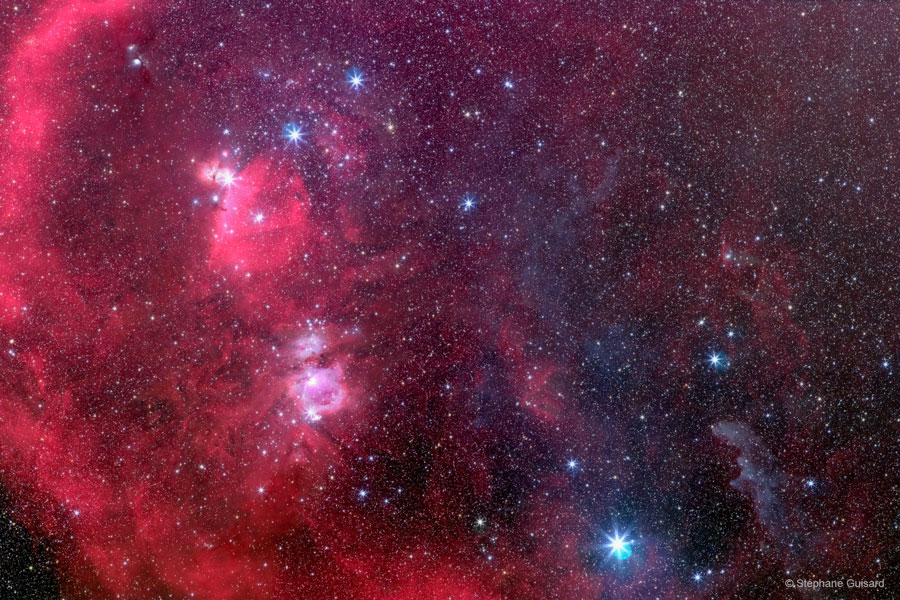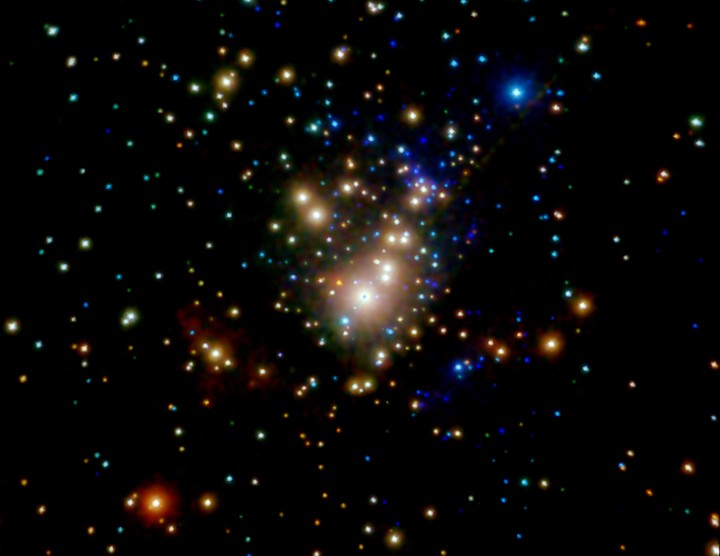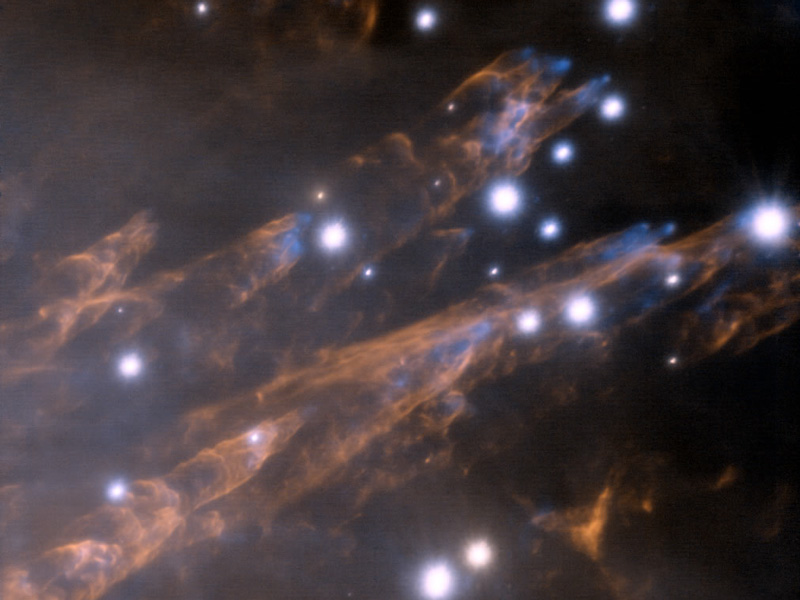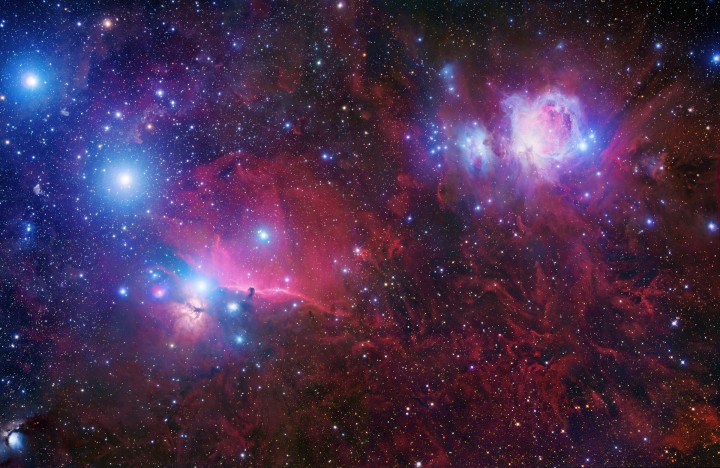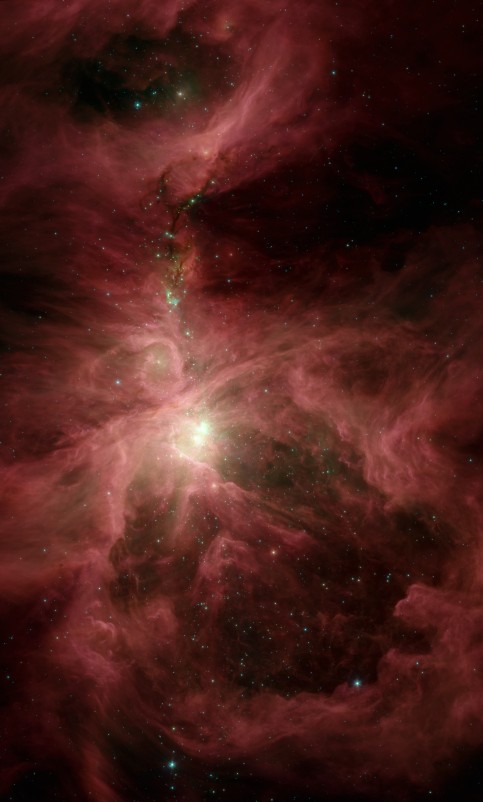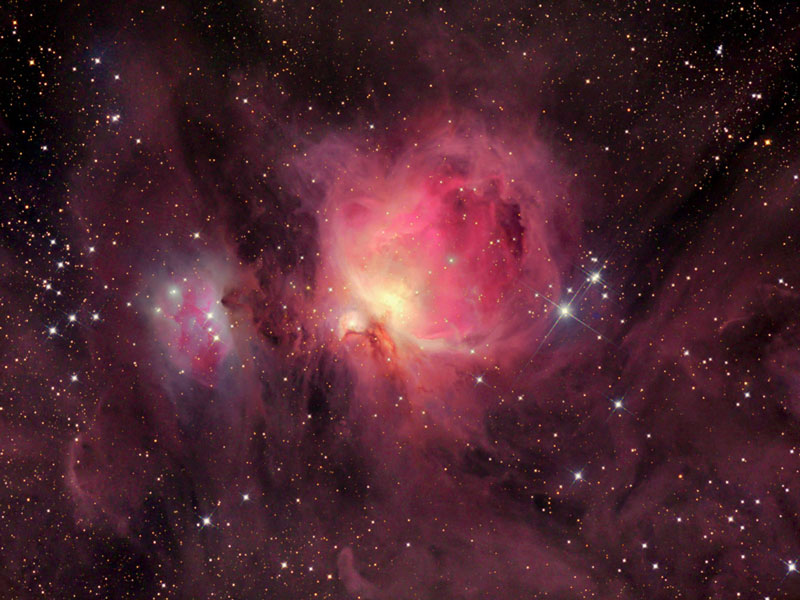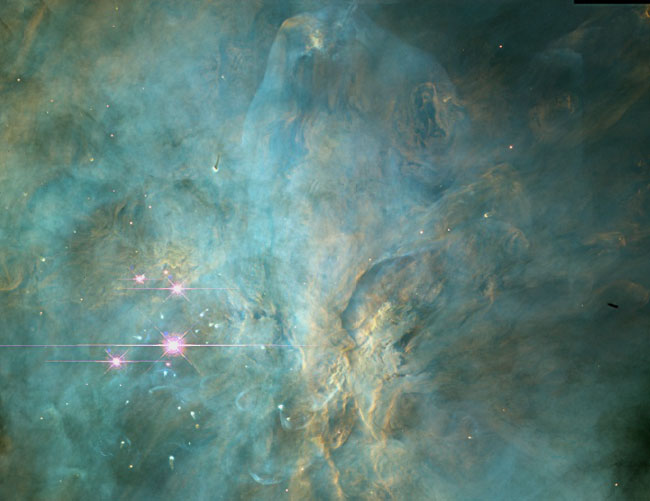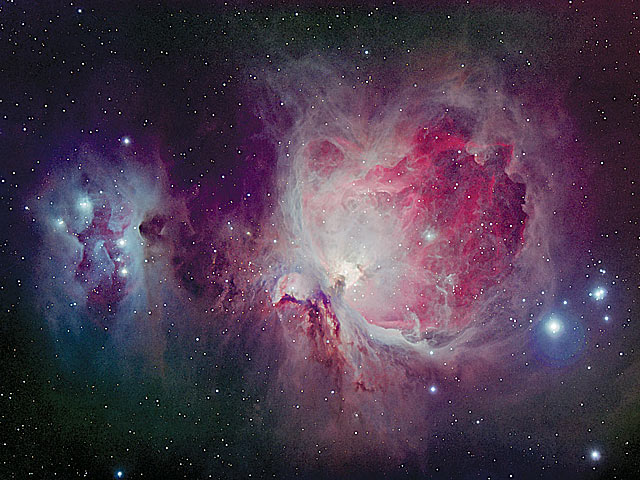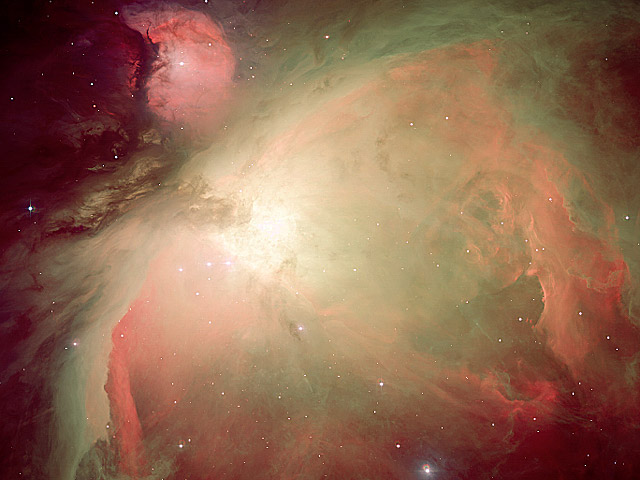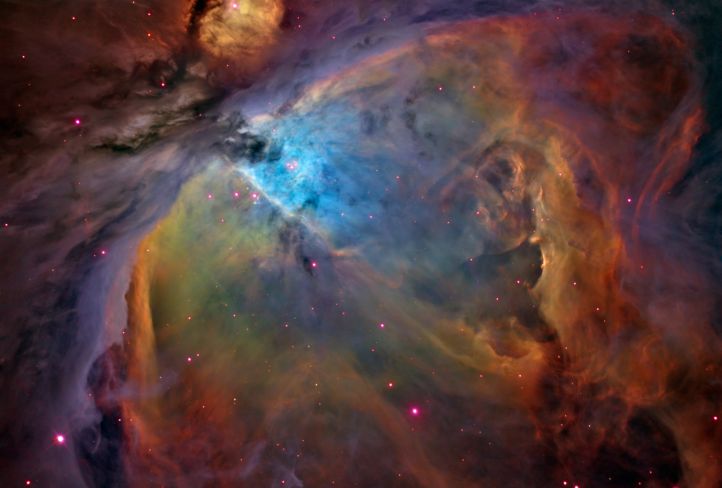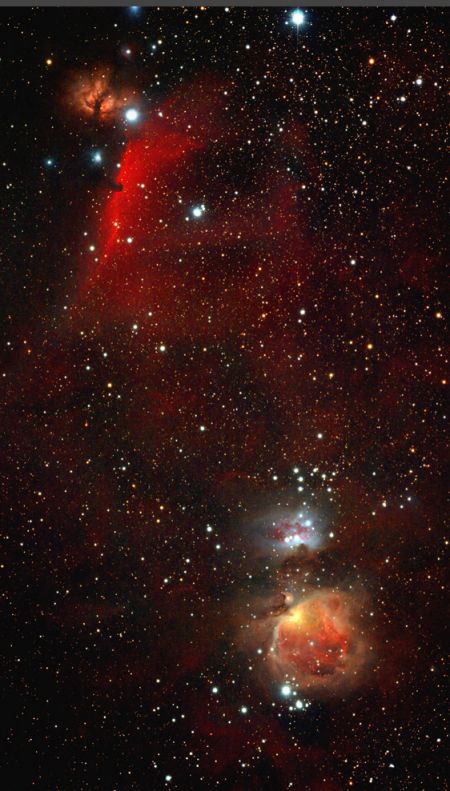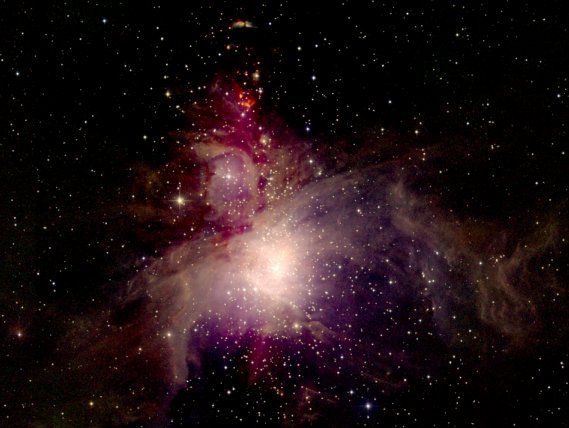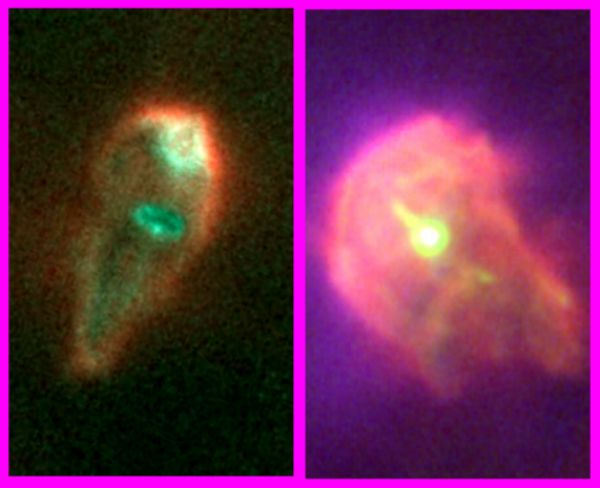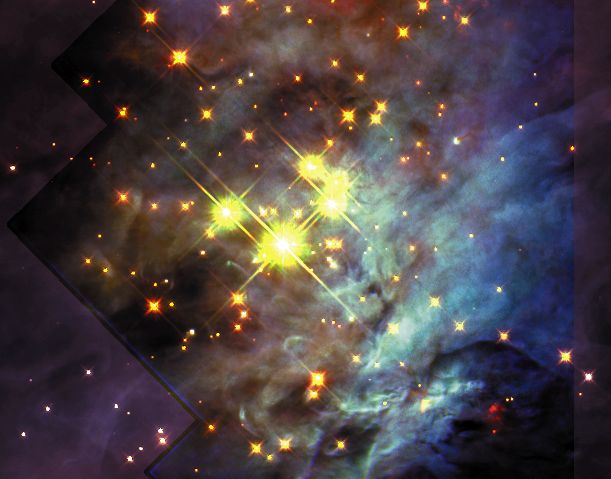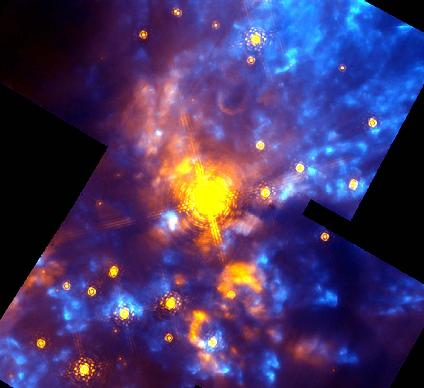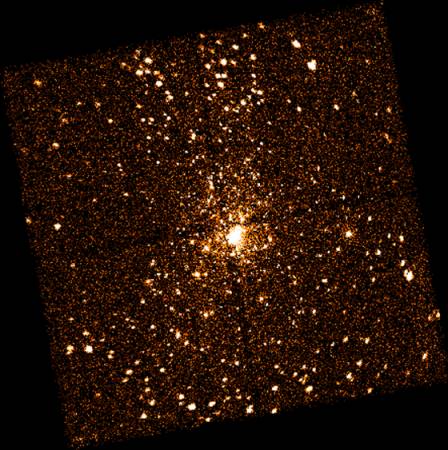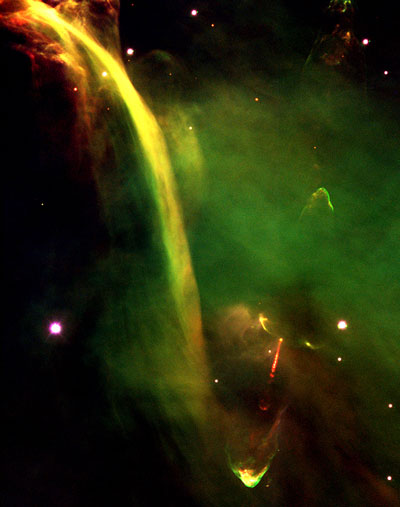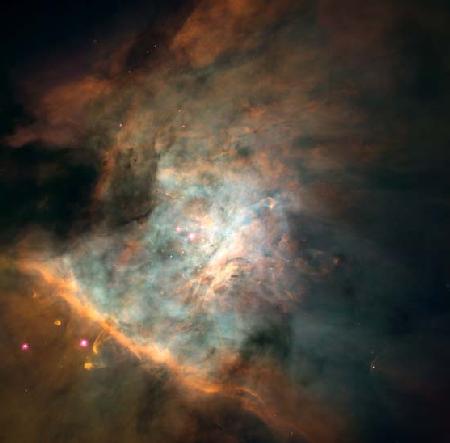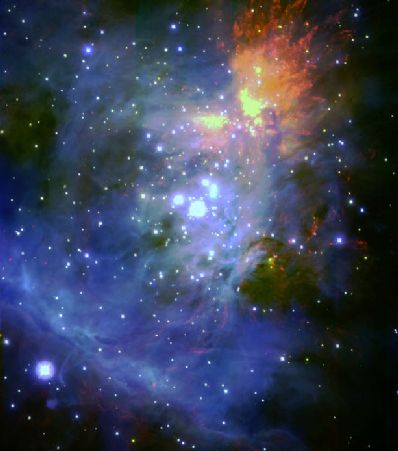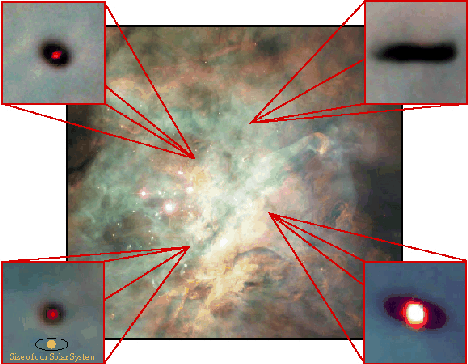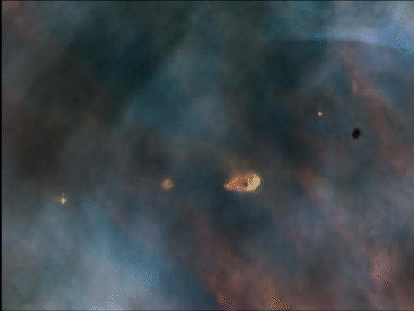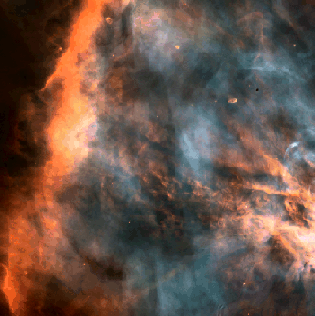M42: Orion Nebula
All titles are clickable and link to the original APOD page. Click on an image for a larger view of it.
2010 October 23 Cradled in cosmic dust and glowing hydrogen, stellar nurseries in Orion the Hunter lie at the edge of a giant molecular cloud some 1,500 light-years away. Spanning nearly 25 degrees, this breath-taking vista stretches across the well-known constellation from head to toe (left to right). The Great Orion Nebula, the closest large star forming region, is right of center. To its left are the Horsehead Nebula, M78, and Orion's belt stars. Sliding your cursor over the picture will also find red giant Betelgeuse at the hunter's shoulder, bright blue Rigel at his foot, and the glowing Lambda Orionis (Meissa) nebula at the far left, near Orion's head. Of course, the Orion Nebula and bright stars are easy to see with the unaided eye, but dust clouds and emission from the extensive interstellar gas in this nebula-rich complex, are too faint and much harder to record. In this mosaic of broadband telescopic images, additional image data acquired with a narrow hydrogen alpha filter was used to bring out the pervasive tendrils of energized atomic hydrogen gas and the arc of the giant Barnard's Loop.
2010 October 5 The dark Horsehead Nebula and the glowing Orion Nebula are contrasting cosmic vistas. Adrift 1,500 light-years away in one of the night sky's most recognizable constellations, they appear in opposite corners of the above stunning mosaic. The familiar Horsehead nebula appears as a dark cloud, a small silhouette notched against the long red glow at the lower left. Alnitak is the easternmost star in Orion's belt and is seen as the brightest star to the left of the Horsehead. Below Alnitak is the Flame Nebula, with clouds of bright emission and dramatic dark dust lanes. The magnificent emission region, the Orion Nebula (aka M42), lies at the upper right. Immediately to its left is a prominent bluish reflection nebula sometimes called the Running Man. Pervasive tendrils of glowing hydrogen gas are easily traced throughout the region.
2010 April 10 Few cosmic vistas excite the imagination like the Orion Nebula, an immense stellar nursery some 1,500 light-years away. Spanning about 40 light-years across the region, this new infrared image from the Spitzer Space Telescope was constructed from data intended to monitor the brightness of the nebula's young stars, many still surrounded by dusty, planet-forming disks. Orion's young stars are only about 1 million years old, compared to the Sun's age of 4.6 billion years. The region's hottest stars are found in the Trapezium Cluster, the brightest cluster near picture center. Spitzer's liquid helium coolant ran out in May 2009, so this false color view is from two channels that still remain sensitive to infrared light at warmer operating temperatures.
2009 December 22 How do planets form? To help find out, the Hubble Space Telescope was tasked to take a detailed look at one of the more interesting of all astronomical nebulae, the Great Nebula in Orion. The Orion nebula, visible with the unaided eye near the belt in the constellation of Orion, is an immense nearby starbirth region and probably the most famous of all astronomical nebulas. Insets to the above mosaic show numerous proplyds, many of which are stellar nurseries likely harboring planetary systems in formation. Some proplyds glow as close disks surrounding bright stars light up, while other proplyds contain disks further from their host star, contain cooler dust, and hence appear as dark silhouettes against brighter gas. Studying this dust, in particular, is giving insight for how planets are forming. Many proplyd images also show arcs that are shock waves - fronts where fast moving material encounters slow moving gas. The Orion Nebula lies about 1,500 light years distant and is located in the same spiral arm of our Galaxy as our Sun.
2009 October 2 These colorful panels both feature a familiar astronomical sight: the stellar nursery known as the Great Orion Nebula. They also offer an intriguing and unfamiliar detail of the nebula rich skyscape -- a passing comet. Recorded this weekend with a remotely operated telescope in New Mexico, the right hand image was taken on September 26 and the left on September 27. Comet 217P Linear sports an extended greenish tail and lies above the bluish Running Man reflection nebula near the top of both frames. Nearby and moving rapidly through the night sky, the comet's position clearly shifts against the cosmic nebulae and background stars from one night to the next. In fact, the comet was a mere 5 light-minutes away on September 27, compared to 1,500 light-years for the Orion Nebula. Much too faint to be seen with the unaided eye, Comet 217P Linear is a small periodic comet with an orbital period of about 8 years. At its most distant point from the Sun, the comet's orbit is calculated to reach beyond the orbit of Jupiter At its closest point to the Sun, the comet still lies just beyond the orbit of planet Earth.
2009 September 29 The constellation of Orion holds much more than three stars in a row. A deep exposure shows everything from dark nebula to star clusters, all embedded in an extended patch of gaseous wisps in the greater Orion Molecular Cloud Complex. The brightest three stars on the far left are indeed the famous three stars that make up the belt of Orion. Just below Alnitak, the lowest of the three belt stars, is the Flame Nebula, glowing with excited hydrogen gas and immersed in filaments of dark brown dust. Below the frame center and just to the right of Alnitak lies the Horsehead Nebula, a dark indentation of dense dust that has perhaps the most recognized nebular shapes on the sky. On the upper right lies M42, the Orion Nebula, an energetic caldron of tumultuous gas, visible to the unaided eye, that is giving birth to a new open cluster of stars. Immediately to the left of M42 is a prominent bluish reflection nebula sometimes called the Running Man that houses many bright blue stars. The above image, a digitally stitched composite taken over several nights, covers an area with objects that are roughly 1,500 light years away and spans about 75 light years.
2009 August 26 The Great Nebula in Orion, also known as M42, is one of the most famous nebulae in the sky. The star forming region's glowing gas clouds and hot young stars are near the center of this colorful deep sky image that includes the smaller nebula M43 and dusty, bluish reflection nebulae NGC 1977 and friends on the left. Located at the edge of an otherwise invisible giant molecular cloud complex, these eye-catching nebulae represent only a small fraction of this galactic neighborhood's wealth of interstellar material. Captured with very modest equipment, the gorgeous skyscape was awarded Best in Show at the 2009 Starfest International Salon of Astrophotography. Judges commented that the detail and shading were exquisite in this version of a classic astronomical image. The field spans nearly 3 degrees or about 75 light-years at the Orion Nebula's estimated distance of 1,500 light-years.
2009 March 10 Adrift 1,500 light-years away in one of the night sky's most recognizable constellations, the glowing Orion Nebula and the dark Horsehead Nebula are contrasting cosmic vistas. They appear in opposite corners of this stunning mosaic taken with a digital camera attached to a small telescope. The magnificent emission region, the Orion Nebula (aka M42), lies at the upper right of the picture. Immediately to its left is a prominent bluish reflection nebula sometimes called the Running Man. The Horsehead nebula appears as a dark cloud, a small silhouette notched against the long red glow at the lower left. Alnitak is the easternmost star in Orion's belt and is seen as the brightest star to the left of the Horsehead. Below Alnitak is the Flame Nebula, with clouds of bright emission and dramatic dark dust lanes. Pervasive tendrils of glowing hydrogen gas are easily traced throughout the region in this deep field image of the same region.
2009 February 22 Few cosmic vistas excite the imagination like the Orion Nebula. Also known as M42, the nebula's glowing gas surrounds hot young stars at the edge of an immense interstellar molecular cloud only 1,500 light-years away. The Orion Nebula offers one of the best opportunities to study how stars are born partly because it is the nearest large star-forming region, but also because the nebula's energetic stars have blown away obscuring gas and dust clouds that would otherwise block our view - providing an intimate look at a range of ongoing stages of starbirth and evolution. This detailed image of the Orion Nebula is the sharpest ever, constructed using data from the Hubble Space Telescope's Advanced Camera for Surveys and the European Southern Observatory's La Silla 2.2 meter telescope. The mosaic contains a billion pixels at full resolution and reveals about 3,000 stars.
2008 December 16 What's that in front of Orion? Forty kilometers north of Kahta, Turkey, lies Mount Nemrut, a mountain adorned with the fragments of vast statues built over 2000 years ago. The stone sculptures once stood nearly 10 meters high and depicted lions, eagles, various ancient gods, and King Antiochus I Theos, who ruled Commagene from 86 BC to 38 BC. Ruins of the bodies of several sitting figures are visible on the hill above, illuminated by moonlight. Zeus' head can be found near the above image's center, while the king's head is seen next closest to the horizon. Visible far in the distance in this image, taken three months ago, is the familiar constellation of Orion. The red patch just below Orion's belt is the Orion Nebula, while the bright star to the left of Orion is Sirius. On the far left, a red and brightening horizon announces that the Sun is beginning to rise.
2008 October 23 The Great Nebula in Orion, also known as M42, is one of the most famous nebulae in the sky. The star forming region's glowing gas clouds and hot young stars are on the right in this sharp and colorful two frame mosaic that includes the smaller nebula M43 near center and dusty, bluish reflection nebulae NGC 1977 and friends on the left. Located at the edge of an otherwise invisible giant molecular cloud complex, these eye-catching nebulae represent only a small fraction of this galactic neighborhood's wealth of interstellar material. Within the well-studied stellar nursery, astronomers have also identified what appear to be numerous infant solar systems. The gorgeous skyscape spans nearly two degrees or about 45 light-years at the Orion Nebula's estimated distance of 1,500 light-years.
2008 October 15 Orion, the Hunter, is one of the most easily recognizable constellations in planet Earth's night sky. But Orion's stars and nebulas don't look quite as colorful to the eye as they do in this lovely camera image, taken early last month at the Black Forest Star Party from Cherry Springs State Park in Pennsylvania, USA. In this single exposure, cool red giant Betelgeuse takes on a yellowish tint as the brightest star at the far left. Otherwise Orion's hot blue stars are numerous, with supergiant Rigel balancing Betelgeuse at the upper right, Bellatrix at the upper left, and Saiph at the lower right. Lined up in Orion's belt (bottom to top) are Alnitak, Alnilam, and Mintaka all about 1,500 light-years away, born of the constellation's well studied interstellar clouds. And if the middle "star" of Orion's sword looks reddish and fuzzy to you, it should. It's the stellar nursery known as the Great Nebula of Orion.
2008 April 8 Do you recognize the belt of Orion in this image? The familiar trio of stars, visible to the unaided eye, can be found across the upper left. Otherwise, the southern part of the constellation Orion has taken on a new look in this unusually deep and wide view First note that the lower left belt star, Alnitak, is the easternmost star in Orion's belt. Left of Alnitak is the Flame Nebula, with clouds of bright emission and dramatic dark dust lanes. Directly below Alnitak, a close inspection will reveal the Horsehead Nebula. Farther right and below is the Orion Nebula, M42, itself visible to the unaided eye. The brightest star in the frame, near the bottom right, is Rigel. A bright blue star, Rigel illuminates the ominously shaped dust patch known as the Witch Head Nebula, visible as the blue reflection nebula near the lower right corner. Finally, appearing as a vast red ring and encompassing the entire region, is Barnard's Loop. Humans could see this entire menagerie, unaided, were their eyes about 10,000 times more sensitive.
2007 October 6 The stars of Orion shine brightly in visible light in planet Earth's night sky. The constellation harbors the closest large stellar nursery, the Great Nebula of Orion, a mere 1,500 light-years away. In fact, the apparently bright clump of stars near the center of this false color Chandra x-ray telescope picture are the massive stars of the Trapezium - the young star cluster which powers much of the nebula's visible-light glow. The stars shown in blue and orange are young sun-like stars; prodigious sources of x-rays thought to be produced in hot stellar coronae and surface flares in a young star's strong magnetic field. Our middle-aged Sun itself was probably thousands of times brighter in x-rays when, like the Trapezium stars, it was only a few million years old. The x-ray image spans about 2.5 light-years across the central region of the Orion Nebula.
2007 March 26 Why are bullets of gas shooting out of the Orion Nebula? Nobody is yet sure. First discovered in 1983, each bullet is actually about the size of our Solar System, and moving at about 400 km/sec from a central source dubbed IRc2. The age of the bullets, which can be found from their speed and distance from IRc2, is very young -- typically less than 1,000 years. As the bullets rip through the interior of the Orion Nebula, a small percentage of iron gas causes the tip of each bullet to glow blue, while each bullet leaves a tubular pillar that glows by the light of heated hydrogen gas. Pictured above, the Orion bullets were captured in unprecedented detail by the adaptive optics technology of the Gemini North telescope. M42, the Orion Nebula, is the closest major star forming region to us and filled with changing dust, gas, and bright stars. The Orion Nebula, is located about 1,500 light years away and can be seen with the unaided eye toward the constellation of Orion.
2007 January 6 Adrift 1,500 light-years away in one of the night sky's most recognizable constellations, the glowing Orion Nebula and the dark Horsehead Nebula are contrasting cosmic vistas. But even fainter filaments of glowing gas are easily traced throughout the region in this stunning composite image that includes exposures filtered to record emission from hydrogen atoms. The view reveals extensive nebulosities associated with the giant Orion Molecular Cloud complex, itself hundreds of light-years across. A magnificent emission region, the Orion Nebula (aka M42) lies at the upper right of the picture. Immediately to its left are a cluster of prominent bluish reflection nebulae sometimes called the Running Man. The Horsehead nebula appears as a dark cloud, a small silhouette notched against the long red glow left of center. Alnitak is the easternmost star in Orion's belt and the brightest star to the left of the Horsehead. Below Alnitak is the Flame Nebula, with clouds of bright emission and dramatic dark dust lanes. Completing the trio of Orion's belt stars, bluish Alnilam and Mintaka form a line with Alnitak, extending to the upper left.
2006 November 20 The Great Nebula in Orion, an immense, nearby starbirth region, is probably the most famous of all astronomical nebulas. Here, glowing gas surrounds hot young stars at the edge of an immense interstellar molecular cloud only 1500 light-years away. In the above deep image, faint wisps and sheets of dust and gas are particularly evident. The Great Nebula in Orion can be found with the unaided eye just below and to the left of the easily identifiable belt of three stars in the popular constellation Orion. In addition to housing a bright open cluster of stars known as the Trapezium, the Orion Nebula contains many stellar nurseries. These nurseries contain hydrogen gas, hot young stars, proplyds, and stellar jets spewing material at high speeds. Also known as M42, the Orion Nebula spans about 40 light years and is located in the same spiral arm of our Galaxy as the Sun.
2006 August 18 Few cosmic vistas excite the imagination like the Orion Nebula, an immense stellar nursery some 1,500 light-years away. Also known as M42, the nebula is visible to the unaided eye, but this stunning infrared view from the Spitzer Space Telescope penetrates the turbulent cosmic gas and dust clouds to explore the region in unprecedented detail. At full resolution, the remarkable image data yields a census of new stars and potential solar systems. About 2,300 young stars surrounded by planet-forming disks were detected based on the infrared glow of their warm dust, along with about 200 stellar embryos, stars too young to have developed disks. This 0.8 by 1.4 degree false-color image is about 20 light-years wide at the distance of the Orion Nebula.
2006 January 20 This aesthetic close-up of cosmic clouds and stellar winds features LL Orionis, interacting with the Orion Nebula flow. Adrift in Orion's stellar nursery and still in its formative years, variable star LL Orionis produces a wind more energetic than the wind from our own middle-aged Sun. As the fast stellar wind runs into slow moving gas a shock front is formed, analogous to the bow wave of a boat moving through water or a plane traveling at supersonic speed. The small, arcing, graceful structure just above and left of center is LL Ori's cosmic bow shock, measuring about half a light-year across. The slower gas is flowing away from the Orion Nebula's hot central star cluster, the Trapezium, located off the upper left corner of the picture. In three dimensions, LL Ori's wrap-around shock front is shaped like a bowl that appears brightest when viewed along the "bottom" edge. The beautiful picture is part of a large mosaic view of the complex stellar nursery in Orion, filled with a myriad of fluid shapes associated with star formation.
2005 September 18 The Great Nebula in Orion, an immense, nearby starbirth region, is probably the most famous of all astronomical nebulas. Here, glowing gas surrounds hot young stars at the edge of an immense interstellar molecular cloud only 1500 light-years away. In the above deep image, faint wisps and sheets of dust and gas are particularly evident. The Great Nebula in Orion can be found with the unaided eye just below and to the left of the easily identifiable belt of three stars in the popular constellation Orion. In addition to housing a bright open cluster of stars known as the Trapezium, the Orion Nebula contains many stellar nurseries. These nurseries contain hydrogen gas, hot young stars, proplyds, and stellar jets spewing material at high speeds. Also known as M42, the Orion Nebula spans about 40 light years and is located in the same spiral arm of our Galaxy as the Sun.
2005 July 10 Start with the constellation of Orion. Near Orion's belt is a fuzzy area known as the Great Nebula of Orion or M42. In this nebula is a bright star cluster known as the Trapezium, shown above. New stellar systems are forming there in gigantic globs of gas and dust known as Proplyds. Looking closely at the above picture also reveals that gas and dust surrounding some of the dimmer stars appears to form structures that point away from the brighter stars. The above false color image was made by combining several exposures from the orbiting Hubble Space Telescope.
2005 April 20 Why is the belt of Orion surrounded by a bubble? Although glowing like an emission nebula, the origin of the bubble, known as Barnard's Loop, is currently unknown. Progenitor hypotheses include the winds from bright Orion stars and the supernovas of stars long gone. Barnard's Loop is too faint to be identified with the unaided eye. The nebula was discovered only in 1895 by E. E. Barnard on long duration film exposures. Orion's belt is seen as the three bright stars across the center of the image, the upper two noticeably blue. Just to the right of the lowest star in Orion's belt is a slight indentation in an emission nebula that, when seen at higher magnification, resolves into the Horsehead Nebula. To the right of the belt stars is the bright, famous, and photogenic Orion Nebula.
2005 April 19 Do you recognize the constellation Orion? This striking but unfamiliar looking picture of the familiar Orion region of the sky was produced using survey data from the now-defunct InfraRed Astronomical Satellite (IRAS). The above image combines information recorded at three different invisible infrared wavelengths and covers about 30x24 degrees on the sky. Most of Orion's visually impressive stars don't stand out, but bright Betelgeuse does appear as a small bright purplish dot on the lower left. The bright region on the right contains the Great Nebula in Orion, while the bright region just above the image bottom is the Rosette Nebula. Surrounding these regions are a jumble of chaotic glowing gas and dark dust jettisoned by stars forming and exploding over millions of years.
2005 January 6 At the edge of a dense molecular cloud, filaments of gas, cosmic dust, and a multitude of young stars beckon in this penetrating image of the Orion Nebula. Alluring structures in the well-known star forming region are revealed here in infrared light as viewed by a new Hawaiian eye - WFCAM - a powerful wide field camera commissioned at the United Kingdom Infrared Telescope (UKIRT) on Mauna Kea. Only a fraction of WFCAM's full field, this picture covers about 11 light-years at the 1,500 light-year distance of the nebula. In the image, otherwise invisible infrared light has been mapped into visible colors. Red represents narrow-band infrared emission from hydrogen molecules at a wavelength of 2.12 microns, green is emission at 2.2 microns, and blue is emission at 1.25 microns. Visible light has a wavelength of about 0.5 microns (micrometers).
2004 September 27 The Great Nebula in Orion is a colorful place. Visible to the unaided eye, it appears as a small fuzzy patch in the constellation of Orion. Long exposure, digitally sharpened images like this, however, show the Orion Nebula to be a busy neighborhood of young stars, hot gas, and dark dust. The power behind much of the Orion Nebula (M42) is the Trapezium - four of the brightest stars in the nebula. Many of the filamentary structures visible are actually shock waves - fronts where fast moving material encounters slow moving gas. The Orion Nebula spans about 40 light years and is located about 1500 light years away in the same spiral arm of our Galaxy as the Sun.
2004 July 13 The Great Nebula in Orion, an immense, nearby starbirth region, is arguably the most famous of all astronomical nebulae. The Orion Nebula, also known as M42, is shown above through ultraviolet and blue filters augmented with three exact colors specifically emitted by hydrogen, oxygen, and sulfur. In addition to housing a bright open cluster of stars known as the Trapezium, the Orion Nebula contains many stellar nurseries. These nurseries contain glowing gas, hot young stars, proplyds, and stellar jets spewing material at high speeds. Many of the filamentary structures visible in this image are actually shock waves - fronts where fast moving material encounters slow moving gas. The Orion Nebula spans about 40 light years and is located about 1500 light years away in the same spiral arm of our Galaxy as the Sun.
2004 March 25 Look up into the sky tonight, and even with a good telescope you won't come across a sight quite like this one. It is a familiar object though, the grand stellar nursery known as the Orion Nebula. But the striking picture combines images taken through three separate filters, each designed to record different emission lines - light from Sulfur, Oxygen, and Hydrogen atoms glowing in the tenuous nebular gas. At such low densities, Sulfur and Hydrogen atoms emit red colors while Oxygen glows green. To distinguish their contributions in the final image, Sulfur was assigned to red, Hydrogen to green, and Oxygen to blue, a color scheme used in mapped-color images of other astronomical nebulae as well. While the result is very different from what the eye might see, the image is still both beautiful and scientifically valuable, tracing elements and conditions within the nearby star forming region.
2004 March 15 Few astronomical sights excite the imagination like the nearby stellar nursery known as the Orion Nebula. The Nebula's glowing gas surrounds hot young stars at the edge of an immense interstellar molecular cloud only 1500 light-years away. The Great Nebula in Orion can be found with the unaided eye just below and to the left of the easily identifiable belt of three stars in the popular constellation Orion. The above image from the 3.6-meter Canada-France-Hawaii Telescope atop a dormant volcano in Hawaii brings out Orion's detail in spectacular fashion. Buried in the complex nebulosity are the bright stars of the Trapezium in Orion's heart, the sweeping lanes of dark dust that cross the center, the pervasive red glowing hydrogen gas, and the blue tinted dust that reflects the light of newborn stars. The whole Orion Nebula cloud complex, which includes the Horsehead Nebula, will slowly disperse over the next 100,000 years.
2002 May 30 Adrift 1,500 light-years away in one of the night sky's most recognizable constellations, the glowing Orion Nebula and the dark Horsehead Nebula are contrasting cosmic vistas. They both appear in this stunning composite color photograph along with other nebulosities as part of the giant Orion Molecular Cloud complex, itself hundreds of light-years across. The magnificent Orion Nebula (aka M42) lies at the bottom of the image. This emission nebula's bright central regions were captured on fast film in a relatively short 30 second exposure. Above M42 are a cluster of prominent bluish reflection nebulae and fainter reddish emission nebulae recorded in additional exposures lasting up to 40 minutes. The Horsehead appears as a dark nebula, a small silhouette notched against the long red glow at the upper left. Alnitak is the easternmost star in Orion's belt and is seen as the brightest star above the Horsehead. Immediately to Alnitak's left is the Flame Nebula, with clouds of bright emission and dramatic dark dust lanes. The telescopic exposures were made from a site in the Southern French Alps at an altitude of 2,800 meters (a little closer to the stars!) in September of 2001.
2002 April 20 Few astronomical sights excite the imagination like the nearby stellar nursery known as the Orion Nebula. The Nebula's glowing gas surrounds hot young stars at the edge of an immense interstellar molecular cloud only 1,500 light-years away. This distinctively detailed image of the Orion Nebula was constructed using data from the 2 Micron All Sky Survey or 2MASS. Using telescopes in the Northern and Southern Hemispheres of planet Earth, the 2MASS project has mapped the entire sky in infrared light. The wavelength of infrared light is longer than visible light but more easily penetrates obscuring dust clouds. 2MASS cameras were sensitive to near infrared wavelengths around 2 microns or about 0.00008 inches. Visible light has a wavelength of about 0.00002 inches. Survey observations in three infrared bands were translated to blue, green, and red colors to produce this composite image.
2001 May 4 The Orion Nebula is a nurturing stellar nursery filled with hot young stars and their natal clouds of gas and dust. But for planetary systems, the active star-forming region can present a hazardous and inhospitable birthplace. While the formation of dusty protoplanetary disks seems common in Orion, these Hubble Space Telescope close-up images dramatically reveal the torturous conditions they must face while trying to grow into full-fledged planetary systems. In each case, a central young star is surrounded by a disk substantially wider than our solar system. The disks likely contain material in the process of planet formation. However, withering ultraviolet radiation from one of Orion's nearby hot stars is rapidly destroying the disks -- ultimately creating the comet-shaped clouds of glowing gas seen engulfing the protoplanetary systems. Planet formation must occur quickly here, if at all. Researchers estimate that about 90 percent of Orion's youngest protoplanetary disks will not survive the next 100,000 years.
2001 January 30 The Great Nebula in Orion is a colorful place. Visible to the unaided eye, it appears as a small fuzzy patch in the constellation of Orion. But this image, a representative-color composite of 81 near-infrared light images taken with VLT's ISAAC, shows the Orion Nebula to be a busy neighborhood of young stars, hot gas, and dark dust. The power behind much of the Orion Nebula (M42) is the Trapezium - four of the brightest stars in the nebula. The eerie blue glow surrounding the bright stars pictured here is their own starlight reflected by nearby dust. Dark brown dust filaments cover much of the region. The whole Orion Nebula cloud complex, which includes the Horsehead Nebula, will slowly disperse over the next 100,000 years.
2000 August 30
2000 May 6 Newborn stars lie at at the heart of the the Orion Nebula, hidden from view by the dust and gas of the giant Orion Molecular Cloud number 1 (OMC-1). Sensitive to invisible infrared wavelengths, Hubble's NICMOS camera can explore the interior of OMC-1 detecting the infrared radiation from infant star clusters and the interstellar dust and atoms energized by their intense starlight. In this false color picture, stars and the glowing dust clouds which also scatter the starlight appear yellowish orange while emission from hydrogen gas is blue. The dramatic image reveals a wealth of details, including many filaments and arcs of gas and dust -- evidence of violent motions stirred-up by the emerging stars. The bright object near the center is the massive young star "BN" (named for its discoverers Becklin and Neugebauer). The pattern of speckles and ripples surrounding BN and other bright stars are image artifacts.
2000 March 31 This false-colour image of the young Trapezium star cluster in the Orion Nebula was made with an infrared camera at wavelengths about twice as long as visible light. The infrared data are part of a sensitive survey of this nearby star forming region in which astronomers have identified over 100 extremely low mass objects -- candidates for elusive brown dwarf stars. Brown dwarfs are failed stars with masses so low (about 8% of the Sun's) that they can not sustain nuclear hydrogen burning, a sun-like star's main energy source. While brown dwarfs are thought to be still massive enough to burn deuterium for energy, thirteen of the low mass objects show evidence of lying below even the deuterium burning limit (about 1.3% of the Sun's mass) falling in a range more commensurate with giant planets. These drifting, "free-floating planets" are perhaps as little as 8 times as massive as Jupiter and likely formed along with the cluster stars a million or so years ago. They are detectable in the infrared because they are still hot from formation, but will eventually cool and fade. If the Trapezium is typical of young star clusters, then the survey results suggest that brown dwarfs and free-floating planets may be fairly common, but there are not enough to solve the mystery of dark matter in the Universe.
2000 February 4 The stars of Orion shine brightly in northern winter skies where the constellation harbors the closest large stellar nursery, the Great Nebula of Orion, a mere 1500 light-years away. In fact, the apparently bright clump of stars near the center of this Chandra X-ray telescope picture of a portion of the nebula are the massive stars of the Trapezium - the young star cluster which powers much of the nebula's visible-light glow. But the sheer number of other stars seen in this X-ray image, which spans about 10 light-years, has surprised and delighted astronomers and this picture was recently touted as the richest field of X-ray sources ever recorded in a single observation. The picture does dramatically illustrate that young stars are prodigious sources of X-rays, thought to be produced in hot stellar coronas and surface flares in a young star's strong magnetic field. Our middle-aged Sun itself was probably thousands of times brighter in X-rays when, like the Trapezium stars, it was only a few million years old. The dark lines through the image are instrumental artifacts.
November 29, 1999 Some features of HH-34 are understood -- some are not. At the core of Herbig-Haro 34 lies a seemingly typical young star. This star, though, somehow ejects energetic "bullets" of high-energy particles, appearing as red streaks toward the lower right of the this image. Astronomers speculate that a burst of these particles might rebound when gas from a disk surrounding the star momentarily collapses onto the star. Visible near the end of each light-year long jet is a glowing cap. HH-34 lies about 1500 light-years away in the Orion Nebula star-forming region. The cause of the large arc of gas on the upper left known as the waterfall remains unexplained.
September 14, 1999 The Great Nebula in Orion is a colorful place. Visible to the unaided eye as a fuzzy patch in the constellation of Orion, this image taken with the Big Throughput Camera shows the Orion Nebula to be a busy neighborhood of young stars, hot gas, and dark dust. The power behind much of the Orion Nebula (M42) is the Trapezium - four of the brightest stars in the nebula. The eerie blue glow surrounding the bright stars pictured here is their own starlight reflected by nearby dust. Hot oxygen and hydrogen gases cause the extended green and pink glows, respectively. Dark brown dust filaments cover much of the region. The whole Orion Nebula cloud complex, which includes the Horsehead Nebula, will slowly disperse over the next 100,000 years.
May 22, 1999 The Great Nebula in Orion, an immense, nearby starbirth region, is probably the most famous of all astronomical nebulae. Here, 15 pictures from the Hubble Space Telescope have been mosaicked to cover the inner 2.5 light years of the nebula and illustrate its diverse nature. In addition to housing a bright open cluster of stars known as the Trapezium, the Orion Nebula contains many stellar nurseries. These nurseries contain hydrogen gas, hot young stars, proplyds, and stellar jets spewing material at high speeds. Most of the filamentary structures visible in this image are actually shock waves - fronts where fast moving material encounters slow moving gas. Shocks are particularly apparent near the bright stars in the lower left of the picture. The Orion Nebula is about 1500 light years distant, located in the same spiral arm of our Galaxy as the Sun.
February 2, 1999 The Orion Nebula (M42) shows a host of treasures when viewed in infrared light. Some stars in the Trapezium, an open cluster of stars at the center, are only visible in infrared light. The orange feature above center is called the Kleinman-Low Nebula, and appears greatly affected by newly forming central star IRc2. The blue emission in this representative color photograph is caused by hot gas ionized by the Trapezium stars. This is one of the first photographs ever taken through Japan's new Subaru Telescope.
April 21, 1998
January 27, 1998 The Great Nebula in Orion can be found just below and to the left of the easily identifiable belt of three stars in the popular constellation Orion. This fuzzy patch contains one of the closest stellar nurseries, lying at a distance of about 1500 light years. In the above picture, the red region on the left consists of nebulae designated M42 and M43 and contains the bright Trapezium open cluster. The blue region on the right is a nebula primarily reflecting the light from internal bright stars. Recent observations of the Orion Nebula by the Hubble Space Telescope have located solar-system sized star-forming regions.
December 7, 1996 How do planets form? Astronomers are finding out by studying one of the most interesting of all astronomical nebulae known, the Great Nebula in Orion. Insets to above mosaic show several planetary systems in formation. The bottom left insert shows the relative size of our own Solar System. The Orion Nebula contains many stellar nurseries. These nurseries contain hydrogen gas, hot young stars, proplyds, and stellar jets spewing material at high speeds. Much of the filamentary structure visible in this image are actually shock waves - fronts where fast moving material encounters slow moving gas. Some shock waves are visible near one of the bright stars in the lower left of the picture. The Orion Nebula is located in the same spiral arm of our Galaxy as is our Sun.
October 17, 1996 Are planets common in our galaxy? Strong evidence that the answer is "yes" was provided in this 1994 image made by the Hubble Space Telescope . A close-up of the Orion Nebulae, it reveals what seem to be disks of dust and gas surrounding newly formed stars. These fuzzy blobs, called "proplyds", appear to be infant solar systems in the process of formation. Of the five stars in this field which spans about 0.14 light years, four appear to have associated proplyds - three bright ones and one dark one seen in silhouette against the bright nebula. A more complete survey of 110 stars in the region found 56 with proplyds. If extra-solar planetary systems are common place, are there extra-terrestrial civilizations out there as well?
July 3, 1995 The Great Nebula in Orion, M42, can be found on the night sky just below and to the left of the easily identifiable belt of three stars in the popular constellation Orion. This nebula is one of the closest stellar nurseries - where young stars are being formed even now. Clumps of gas (mostly hydrogen and helium) and dust in the nebula are squeezed together by their own gravity until they collapse and form stars. Some stars we can see here partially obscured by the nebula, are only about 100,000 years old - just babies compared to the 5 billion (5,000,000,000) years of our Sun.
